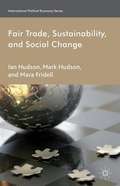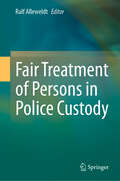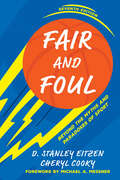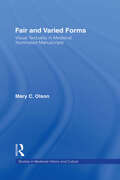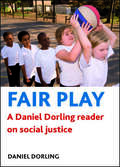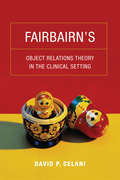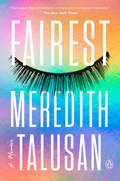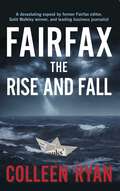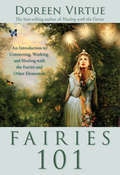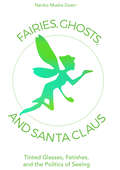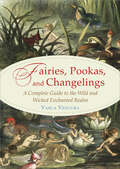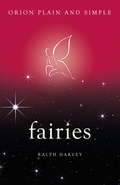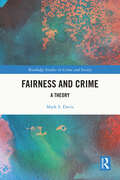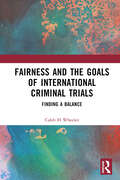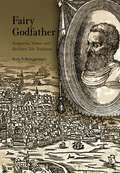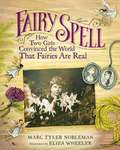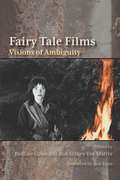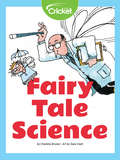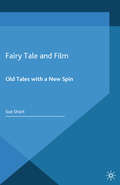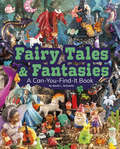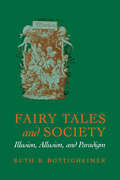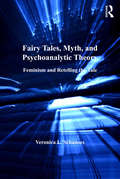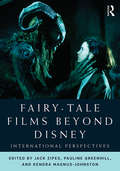- Table View
- List View
Fair Trade, Sustainability, and Social Change
by Mark Hudson Ian Hudson Mara FridellThe authors critically evaluate the fair trade movement's role in pursuing a more just and environmentally sustainable society. Using fair trade as a case study of the shift toward non-state forms of governance, they focus on its role not only as a regulatory tool, but as a catalyst for broader social and political transformation.
Fair Treatment of Persons in Police Custody
by Ralf AlleweldtThis book analyses and evaluates the international efforts to ensure the fair and human treatment of persons in police custody. Respecting the dignity of all detained persons, and in particular preventing torture, is a key issue of international human rights protection. The authors explore various approaches to tackle this issue, including the introduction of investigative, non-coercive interviewing techniques as well as the implementation of fundamental safeguards such as the access to a lawyer and a doctor. Supported by case studies, they describe the special role of national preventive mechanisms and the efforts to improve the treatment of detainees in the context of capacity building activities. Police components of international peace missions face special legal and practical human rights challenges. Authors also ask how the positive potentials and strengths within police organisations could be mobilised for realising human rights, and, last but not least, they seek to assess the prospects of how fair treatment of persons in police custody may be ensured in the future effectively.
Fair and Foul: Beyond the Myths and Paradoxes of Sport
by D. Stanley Eitzen Cheryl CookySport is a pervasive aspect of US society. Most children in the U.S. are involved in organized sport and it’s the subject of much conversation, media content, leisure activity, and discretionary spending. There is a growing number of broadcast networks, online news sites, social media accounts, and streaming platforms devoted to covering sports that fans consume with keen interest. But do we truly understand sport? <P><P> Fair and Foul explores our love of sport, just as it reveals sport’s darker side—the influence of big business, corruption, price gouging, political maneuvering, gender bias, media grandstanding, and more. Broken into two parts, Part I, “Sport is Fair, Sport is Foul,” discusses issues of social class, race, gender, and health as well as the opportunities and demands of youth sports. Part II, “Sports as a Microcosm of Society,” examines issues stemming from the media, college athletics, professional sports franchises, and whether it’s possible to bring about change for a better and brighter future.
Fair and Varied Forms: Visual Textuality in Medieval Illustrated Manuscripts (Studies in Medieval History and Culture #Vol. 15)
by Mary C. OlsonFirst published in 2003. Research in Medieval Studies continues to be fresh in these volumes in the Medieval History and Culture series which includes studies on individual works and authors or Latin and vernacular literatures, historical personailities and events, theological and philosophical issues and new critical approaches to medieval literature and culture.
Fair play: A Daniel Dorling reader on social justice
by Daniel DorlingThis accessible reader brings together a selection of highly influential writings by Danny Dorling which look at inequality and social justice, why they matter and what they are. Encompassing an extensive range of print and online media - including newspaper articles and key publications - 'Fair Play' provides evidence that Britain is becoming more politically, socially and economically divided whilst coming together in terms of educational outcomes and reduced segregation by ethnicity.
Fairbairn's Object Relations Theory in the Clinical Setting
by David P. CelaniW. R. D. Fairbairn (1889-1964) challenged the dominance of Freud's drive theory with a psychoanalytic theory based on the internalization of human relationships. Fairbairn assumed that the unconscious develops in childhood and contains dissociated memories of parental neglect, insensitivity, and outright abuse that are impossible the children to tolerate consciously. In Fairbairn's model, these dissociated memories protect developing children from recognizing how badly they are being treated and allow them to remain attached even to physically abusive parents. Attachment is paramount in Fairbairn's model, as he recognized that children are absolutely and unconditionally dependent on their parents. Kidnapped children who remain attached to their abusive captors despite opportunities to escape illustrate this intense dependency, even into adolescence. At the heart of Fairbairn's model is a structural theory that organizes actual relational events into three self-and-object pairs: one conscious pair (the central ego, which relates exclusively to the ideal object in the external world) and two mostly unconscious pairs (the child's antilibidinal ego, which relates exclusively to the rejecting parts of the object, and the child's libidinal ego, which relates exclusively to the exciting parts of the object). The two dissociated self-and-object pairs remain in the unconscious but can emerge and suddenly take over the individual's central ego. When they emerge, the "other" is misperceived as either an exciting or a rejecting object, thus turning these internal structures into a source of transferences and reenactments. Fairbairn's central defense mechanism, splitting, is the fast shift from central ego dominance to either the libidinal ego or the antilibidinal ego-a near perfect model of the borderline personality disorder. In this book, David Celani reviews Fairbairn's five foundational papers and outlines their application in the clinical setting. He discusses the four unconscious structures and offers the clinician concrete suggestions on how to recognize and respond to them effectively in the heat of the clinical interview. Incorporating decades of experience into his analysis, Celani emphasizes the internalization of the therapist as a new "good" object and devotes entire sections to the treatment of histrionic, obsessive, and borderline personality disorders.
Fairest: A Memoir
by Meredith Talusan<P><P>A singular, beautifully written coming-of-age memoir of a Filipino boy with albinism whose story travels from an immigrant childhood to Harvard to a gender transition and illuminates the illusions of race, disability, and gender <P><P>Fairest is a memoir about a precocious boy with albinism, a "sun child" from a rural Philippine village, who would grow up to become a woman in America. <P><P> Coping with the strain of parental neglect and the elusive promise of U.S. citizenship, Talusan found childhood comfort from her devoted grandmother, a grounding force as she was treated by others with special preference or public curiosity. As an immigrant to the United States, Talusan came to be perceived as white. An academic scholarship to Harvard provided access to elite circles of privilege but required Talusan to navigate through the complex spheres of race, class, sexuality, and her place within the gay community. She emerged as an artist and an activist questioning the boundaries of gender. <P><P>Talusan realized she did not want to be confined to a prescribed role as a man, and transitioned to become a woman, despite the risk of losing a man she deeply loved. Throughout her journey, Talusan shares poignant and powerful episodes of desirability and love that will remind readers of works such as Call Me By Your Name and Giovanni's Room. Her evocative reflections will shift our own perceptions of love, identity, gender, and the fairness of life.
Fairfax: The Rise and Fall: Updated Edition
by Colleen RyanFairfax - once a great Australian media company - faces a grim future. Newspapers worldwide are faltering in the face of competition from the internet, but the fate of Fairfax stands out as being particularly cruel. The carnage is barely credible. Massive printing plants are being dismantled. Hundreds of fine journalists have been ushered from the building. The newspapers themselves are on notice. The future of the company is shaky. Fairfax: The Rise and Fall is a story that is book-ended by young Warwick Fairfax and Gina Rinehart—the eccentric beneficiaries of two of the greatest family fortunes Australia has ever seen. But the real players in the Fairfax saga are the business and political giants. They include Kerry Packer, Rupert Murdoch, Conrad Black, John Howard, Paul Keating, Neville Wran, David Gonski, Roger Corbett and Fred Hilmer. The once-mighty Fairfax has been a victim of them all. Colleen Ryan gives the definitive account of the fate of Fairfax, a drama-filled saga that reveals how far Fairfax has fallen
Fairies 101: An Introduction To Connecting, Working, And Healing With The Fairies And Other Elementals
by Doreen VirtueFairies are very real and loving beings who want to help us live joyful, prosperous, and healthy lives. In this enlightening book, Doreen Virtue clearly explains who the fairies are, how they’re helping us, and ways to connect with their magical energy. True stories from people who’ve encountered fairies and benefited from their assistance illustrate Doreen’s teachings. You’ll learn how fairies aid people in finding lost objects, heal themselves and their pets, make gardens grow miraculously fast, and help clean the environment. You’ll also see photos of a real fairy handprint, and other visual evidence that demonstrates that fairies are very real indeed.
Fairies and Elves (The Enchanted World Series)
by Time-Life BooksDescribes folklore about fairies and elves from around the world.
Fairies, Ghosts, and Santa Claus: Tinted Glasses, Fetishes, and the Politics of Seeing
by Neriko Musha DoerrInvestigating the politics of seeing and its effects, this book draws on Slavoj Žižek’s notion of fetish and Walter Benjamin’s notion of the optical unconscious to offer newer concepts: “tinted glasses”, through which we see the world; “unit-thinking”, which renders the world as consisting of discrete units; and “coherants”, which help fragmented experiences cohere into something intelligible. Examining experiences at a Japanese heritage language school, a study-abroad trip to Sierra Leone, as well as in college classrooms, this book reveals the workings of unit-thinking and fetishism in diverse contexts and explores possibilities for social change.
Fairies, Pookas, and Changelings: A Complete Guide to the Wild and Wicked Enchanted Realm
by Varla VenturaAn exploration of the different tenants of Fairyland from around the world—hobgoblins, sprites, bogeys, pixies, goblins, bonga, duende, elves, and more.While it’s true that fairy folk love a good garden and take great pleasure in a tulip, there are dozens of beasties who fall under the fairy domain that are not quite as delightful as the quintessential flower fairy. This book is an exploration of the many things that go bump in the night near the fairy mound. Along with an exploration of folklore and historical literature, readers will delight in fairy tales that demonstrate everything from striking a bargain with a fairy to staving off changelings to laughing with the dwarves.Included are fairy tales and myths from Wales, Scotland, Ireland, and Scandinavia plus classic stories by Thomas Crofton Croker, Joseph Jacobs, Clara Stroebe, the Brothers Grimm, Hans Christian Andersen, Yei Theodora Ozaki, and others on goblins, trolls, gnomes, pookas, changelings, banshees, and more!Chapters include:A Fear of Little Men: Elves, Trolls, Leprechauns, Tree Spirits, Brownies, Coblyns, Dwarves, Goblins, Bonga, Trolls and Other Fairy Folk of Glen, Forests and HearthThe Hand That Rocks the Cradle: Changelings and Other Greedy Kidnappers of the Fairy KingdomI’m Not Drunk, It’s Just My Pooka: Tales of the Trickster Fairy and Its Wild CounterpartIs That All There Is? Fairies Who Give, or The Barter SystemWhoops, There It Is: How to Enter the Fairy Kingdom (or How Not To)If you think fairies are merely delicate beings who follow you about on gossamer wings, consider yourself warned! The kingdom of the fairy is one of vengeance, thievery, trickery, and wild creatures.
Fairies: The Only Book You'll Ever Need (Plain And Simple Ser.)
by Ralph HarveyA practical guide on the fairy realm.
Fairness and Crime: A Theory (Routledge Studies in Crime and Society)
by Mark S. DavisCriminology, the discipline that informs our understanding of crime and justice, is facing an identity crisis. Long dominated by sociology’s view of crime and its causes, criminology has recently witnessed the rise of a new cadre of academics who feel free to explore other explanations. Fairness and Crime: A Theory offers a comprehensive new perspective on criminal behavior that will reinvigorate the field and help us understand why we consider some acts criminal as well as why and how society should respond to those acts.In this book, Mark S. Davis connects the challenges of understanding crime and administering justice to common norms that guide behavior in everyday life. He contends that the exchanges society defines as criminal work basically the way all other exchanges, and when offenders rob banks, bilk investors, or fabricate scientific data, they engage in a violation of fairness norms. Davis offers a theory that is informed by insights from game theory research, anthropology, law, organizational/industrial psychology, personality/social psychology, and sociology. He utilizes examples drawn from everyday life to illustrate the theory’s concepts in detail.Fairness and Crime: A Theory provides a platform from which to explore the purposes of the criminal justice system. What are we trying to accomplish when we prosecute criminal suspects? While one answer is that we are trying to vindicate the moral order and deter future offending, another is that we are attempting to restore equity for victims caused by offenders’ exploitative or retaliatory behavior. Davis contends that addressing unfairness is what the criminal justice system should be about. In rehabilitation, we should be trying to inculcate fairness norms where they are absent or where they have been compromised.
Fairness and the Goals of International Criminal Trials: Finding a Balance
by Caleb H WheelerThis book presents a ground-breaking, interdisciplinary study into the various goals assigned to international criminal trials. It starts from the proposition that no hierarchy exists amongst the different goals meaning that trials should strive to achieve all of them in equal measure. This is made difficult by the fact that not all of these goals are compatible and the fulfilment of one may lead to others going unmet. Therefore, a balance must be found if the goals of trial are to be achieved at all. The book posits that fairness should serve as the guiding principle when weighing the different trial goals against one another. It is argued that without fairness international and internationalised criminal courts and tribunals lack legitimacy and without legitimacy they lack effectiveness. The book concludes that international criminal trials must adopt procedures that emphasise fairness to all of the parties and trial participants if they wish to accomplish any of the goals set for them. Each chapter is devoted to identifying and explaining a different trial goal, providing analysis of how that particular goal functions in conjunction with the other goals, and discussing the ways in which a fairness oriented trial model will help achieve those goals. The book provides a dynamic understanding of the different trial goals and the importance of fairness in the trial process by drawing on research from a variety of different legal disciplines while also incorporating scholarship rooted in criminology, political theory, international relations, and psychology. The book will be essential reading for researchers, academics and professionals working in the areas of International Criminal Law, Public International Law and Transitional Justice.
Fairy Godfather
by Ruth B. BottigheimerIn the classic rags-to-riches fairy tale a penniless heroine (or hero), with some magic help, marries a royal prince (or princess) and rises to wealth. Received opinion has long been that stories like these originated among peasants, who passed them along by word of mouth from one place to another over the course of centuries. In a bold departure from conventional fairy tale scholarship, Ruth B. Bottigheimer asserts that city life and a single individual played a central role in the creation and transmission of many of these familiar tales. According to her, a provincial boy, Zoan Francesco Straparola, went to Venice to seek his fortune and found it by inventing the modern fairy tale, including the long beloved Puss in Boots, and by selling its many versions to the hopeful inhabitants of that colorful and commercially bustling city.With innovative literary sleuthing, Bottigheimer has reconstructed the actual composition of Straparola's collection of tales. Grounding her work in social history of the Renaissance Venice, Bottigheimer has created a possible biography for Straparola, a man about whom hardly anything is known. This is the first book-length study of Straparola in any language.
Fairy Spell: How Two Girls Convinced the World That Fairies Are Real
by Marc Tyler Nobleman Eliza WheelerIn 1917, in Cottingley, England, a girl named Elsie took a picture of her younger cousin, Frances. Also in the photo was a group of fairies, fairies that the girls insisted were real. Through a remarkable set of circumstances, that photograph and the ones that followed came to be widely believed as evidence of real fairies. It was not until 1983 that the girls, then late in life, confessed that the Cottingley Fairies were a hoax. <P><P> Their take is an extraordinary slice of history, from a time when anything in a photograph was assumed to be fact and it was possible to trick an eager public into believing something magical. Exquisitely illustrated with art and the original fairy photographs.
Fairy Tale Films: Visions of Ambiguity
by Greenhill, Pauline; Matrix, Sidney EveIn this, the first collection of essays to address the development of fairy tale film as a genre, Pauline Greenhill and Sidney Eve Matrix stress, "the mirror of fairy-tale film reflects not so much what its audience members actually are but how they see themselves and their potential to develop (or, likewise, to regress)." As Jack Zipes says further in the foreword, “Folk and fairy tales pervade our lives constantly through television soap operas and commercials, in comic books and cartoons, in school plays and storytelling performances, in our superstitions and prayers for miracles, and in our dreams and daydreams. The artistic re-creations of fairy-tale plots and characters in film—the parodies, the aesthetic experimentation, and the mixing of genres to engender new insights into art and life—mirror possibilities of estranging ourselves from designated roles, along with the conventional patterns of the classical tales.” Here, scholars from film, folklore, and cultural studies move discussion beyond the well-known Disney movies to the many other filmic adaptations of fairy tales and to the widespread use of fairy tale tropes, themes, and motifs in cinema.
Fairy Tale Science
by Charlene BrussoIs magic real? Fairy tales are stories that teach us moral issues, often with the use of magic. But what would happen to those stories if they were set in the real world? See how science and technology can create the "magic" you see in your favorite fairy tales.
Fairy Tale and Film: Old Tales with a New Spin
by S. ShortSue Short examines how fairy tale tropes have been reworked in contemporary film, identifying familiar themes in a range of genres – including rom coms, crime films and horror – and noting key similarities and differences between the source narratives and their offspring.
Fairy Tales and Fantasies: A Can-You-Find-It Book (Can You Find It?)
by Sarah L. SchuetteShow kids their favorite fairy tales and fantasies with this fun seek-and-find title. Hundreds of objects are hidden inside full-color photo puzzles of fairy-tale and fantasy characters, settings, and more. Each to-find list includes pictographs and word labels to engage pre-readers and early readers alike.
Fairy Tales and Society: Illusion, Allusion, and Paradigm
by Ruth B. BottigheimerThis collection of exemplary essays by internationally recognized scholars examines the fairy tale from historical, folkloristic, literary, and psychoanalytical points of view. For generations of children and adults, fairy tales have encapsulated social values, often through the use of fixed characters and situations, to a far greater extent than any other oral or literary form. In many societies, fairy tales function as a paradigm both for understanding society and for developing individual behavior and personality. A few of the topics covered in this volume: oral narration in contemporary society; madness and cure in the 1001 Nights; the female voice in folklore and fairy tale; change in narrative form; tests, tasks, and trials in the Grimms' fairy tales; and folklorists as agents of nationalism. The subject of methodology is discussed by Torborg Lundell, Stven Swann Jones, Hans-Jorg Uther, and Anna Tavis.
Fairy Tales and the Art of Subversion: The Classical Genre For Children And The Process Of Civilization (Routledge Classics Ser.)
by Jack ZipesThe fairy tale may be one of the most important cultural and social influences on children's lives. But until Fairy Tales and the Art of Subversion, little attention had been paid to the ways in which the writers and collectors of tales used traditional forms and genres in order to shape children's lives – their behavior, values, and relationship to society. As Jack Zipes convincingly shows, fairy tales have always been a powerful discourse, capable of being used to shape or destabilize attitudes and behavior within culture.For this new edition, the author has revised the work throughout and added a new introduction bringing this classic title up to date.
Fairy Tales, Myth, and Psychoanalytic Theory: Feminism and Retelling the Tale (Ashgate Studies In Childhood, 1700 To The Present Ser.)
by Veronica L. SchanoesAt the same time that 1970s feminist psychoanalytic theorists like Jean Baker Miller and Nancy Chodorow were challenging earlier models that assumed the masculine psyche as the norm for human development and mental/emotional health, writers such as Anne Sexton, Olga Broumass, and Angela Carter were embarked on their own revisionist project to breathe new life into fairy tales and classical myths based on traditional gender roles. Similarly, in the 1990s, second-wave feminist clinicians continued the work begun by Chodorow and Miller, while writers of fantasy that include Terry Windling, Tanith Lee, Terry Pratchett, and Catherynne M. Valente took their inspiration from revisionist authors of the 1970s. As Schanoes shows, these two decades were both particularly fruitful eras for artists and psychoanalytic theorists concerned with issues related to the development of women's sense of self. Putting aside the limitations of both strains of feminist psychoanalytic theory, their influence is undeniable. Schanoes's book posits a new model for understanding both feminist psychoanalytic theory and feminist retellings, one that emphasizes the interdependence of theory and art and challenges the notion that literary revision involves a masculinist struggle with the writer's artistic forbearers.
Fairy-Tale Films Beyond Disney: International Perspectives
by Jack Zipes Pauline Greenhill Kendra Magnus-JohnstonThe fairy tale has become one of the dominant cultural forms and genres internationally, thanks in large part to its many manifestations on screen. Yet the history and relevance of the fairy-tale film have largely been neglected. In this follow-up to Jack Zipes’s award-winning book The Enchanted Screen (2011), Fairy-Tale Films Beyond Disney offers the first book-length multinational, multidisciplinary exploration of fairy-tale cinema. Bringing together twenty-three of the world’s top fairy-tale scholars to analyze the enormous scope of these films, Zipes and colleagues Pauline Greenhill and Kendra Magnus-Johnston present perspectives on film from every part of the globe, from Hayao Miyazaki’s Spirited Away, to Jan Švankmajer’s Alice, to the transnational adaptations of 1001 Nights and Hans Christian Andersen. Contributors explore filmic traditions in each area not only from their different cultural backgrounds, but from a range of academic fields, including criminal justice studies, education, film studies, folkloristics, gender studies, and literary studies. Fairy-Tale Films Beyond Disney offers readers an opportunity to explore the intersections, disparities, historical and national contexts of its subject, and to further appreciate what has become an undeniably global phenomenon.
